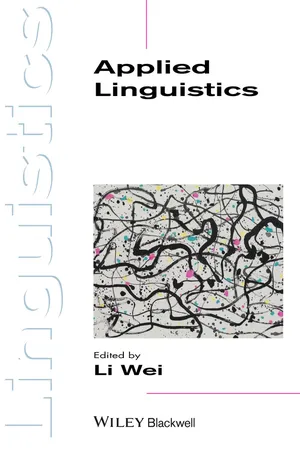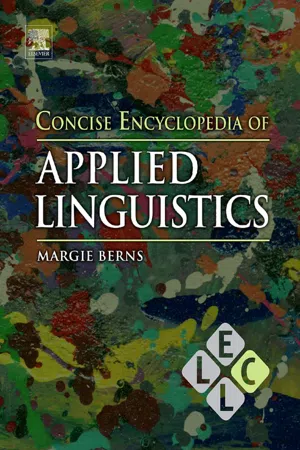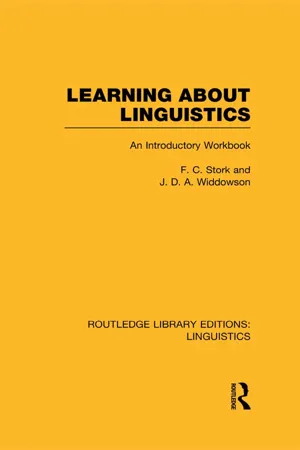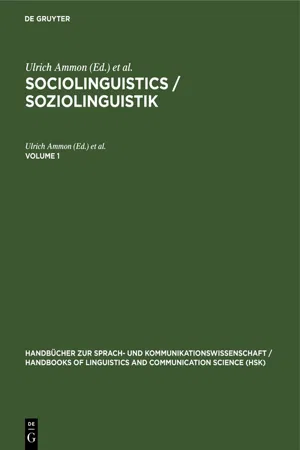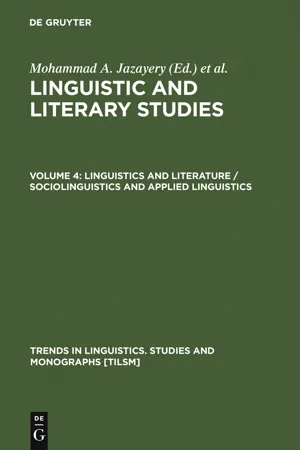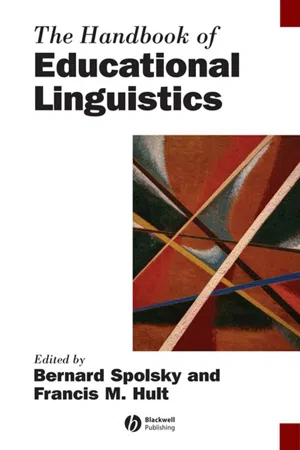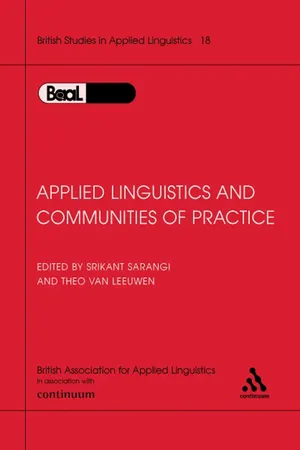Languages & Linguistics
Applied Linguistics
Applied Linguistics is the study of how language is used in real-world contexts, such as language teaching, translation, and language policy. It seeks to address practical issues related to language use and to improve communication across different languages and cultures. Applied linguists often work in areas such as language education, language assessment, and language planning.
Written by Perlego with AI-assistance
Related key terms
1 of 5
10 Key excerpts on "Applied Linguistics"
- eBook - ePub
- Li Wei(Author)
- 2013(Publication Date)
- Wiley-Blackwell(Publisher)
If you describe yourself as a linguist to other people outside the discipline, chances are that they will ask you, ‘How many languages do you speak?’ But if you describe yourself as an Applied Linguist, they may well go silent completely, wondering what they should say to you next. If you are lucky, you might get asked, ‘Is that how to teach languages?’ or ‘Is that translation?’ These questions are not entirely unreasonable, as Applied Linguistics can mean different things to different people, even among those who would describe themselves as Applied Linguists.The International Association of Applied Linguistics (AILA) proclaims:Applied Linguistics is an interdisciplinary field of research and practice dealing with practical problems of language and communication that can be identified, analysed or solved by applying available theories, methods or results of Linguistics or by developing new theoretical and methodological frameworks in linguistics to work on these problemsThe AILA definition is both broad in including, potentially, many different areas such as child language acquisition, language and communication disorders, multilingualism, language testing, communication in the workplace, and so on, and narrow in relating Applied Linguistics to linguistics proper. The latter has caused a perpetual controversy, not least because linguistics has also been conceptualized in many different ways to produce a unified theory. In this introductory chapter, we begin with a discussion of what linguistics is, focusing, in particular, on the differences as well as the similarities between the different approaches to language. The main objective is to highlight the connections between the various branches and sub-branches of linguistics, as Applied Linguists may apply one specific approach or a combination of several different ones to the problems that they wish to solve. We then go on to describe Applied Linguistics as a problem-solving approach, outlining its key elements and characteristics. A substantial part of the chapter, Section 1.3, is on the methodological considerations in doing Applied Linguistics, covering all the main stages of doing a research project. The last section outlines the structure and content of the book. - eBook - PDF
- Margie Berns(Author)
- 2010(Publication Date)
- Elsevier(Publisher)
In fact, Halliday holds the view that all linguistics is sociolinguistics; that is, the study of language is the study of language in use. Interdisciplinarity and Applied Linguistics For some time, language teaching – first, second, and foreign – has been synonymous with applied linguis-tics. Since the development and improvement of class-room acquisition and competence in languages is a central educational concern for society, it is not surprising that this is one area that has long had the attention of applied linguists. This, however, was not the intention of the founders of contemporary Applied Linguistics, whose public and published statements on the scope of the field insisted that language teaching was but one example of the areas in which theories and methods of linguistics (in its broadest sense as the study of language) have relevance. This broader and more flexible interpretation of Applied Linguistics not 4 Applied Linguistics only recognizes the limitations of relying solely on linguistics as a source field; it also recognizes that the language problems that applied linguists address are found in many areas of human life. Although language teaching and learning remain primary concerns in many non-Western settings, elsewhere applied linguistic activity focuses on a range of language-related issues and often draws upon other disciplines in studying language problems. Engaging expertise from other professions (e.g., med-icine and law) or fields of study (e.g., psychology, communication studies, or sociology) presupposes precise identification of the problem to determine its scope. Related disciplines are tapped for avail-able facts, techniques, and theories that can aid in addressing the problem. In some cases, there may be close collaboration with practitioners from these disciplines. - eBook - ePub
- F.C. Stork, J.D.A. Widdowson(Authors)
- 2014(Publication Date)
- Routledge(Publisher)
9. Some Practical Applications of Linguistics Language is such a fundamental and important part of human behaviour, particularly in an advanced literate society, that the nature and structure of language is worth studying in its own right and the science of linguistics, or General Linguistics as it is sometimes called, does just that. In the preceding chapters we have surveyed briefly some of the main trends and cross currents in linguistic thought and we have shown how the work of linguists, particularly in the twentieth century, has increased our understanding of what is involved in the use of language as a means of communication. So far, however, we have said nothing about the use made of this new knowledge in practical activities, but since language is basic to our personal and social lives it would be very surprising indeed if the better understanding of language did not have wider applications in many disciplines and fields of human experience. Recently there has been a greater recognition of the fact that linguistics does have such applications and the term Applied Linguistics has been used for some time to refer to a set of methods and procedures involving the application of linguistic theory to practical problems. Language teaching is the most obvious area where linguistics would seem to be relevant, and in some cases the term Applied Linguistics is used synonymously with the application of linguistics to language teaching. It is not difficult to see why this should be, for the language barrier has always been one of the most pressing problems in education and communication. This was true in the days when monks made the earliest interlinear glosses on manuscripts as an aid to learning and teaching Latin and it is even more true today in an age which has experienced an ‘explosion’ in the amount of information to be communicated - eBook - PDF
- Ulrich Ammon, Norbert Dittmar, Klaus J. Mattheier, Peter Trudgill, Ulrich Ammon, Norbert Dittmar, Klaus J. Mattheier, Peter Trudgill(Authors)
- 2020(Publication Date)
- De Gruyter Mouton(Publisher)
This can be done with the aid of translating or even speaking com-puters, by supplying foreign-language teach-ing with new methods, a didactic grammar or basic vocabularies, but also by the stan-dardization or international unification of terminologies and in many other ways. — There can be no denying the fact that the larger part of human communication in our era of scientific and technological progress is concerned with science and technology or at least with their output in industrial produc-tion. The means of communication in these spheres of life and work are languages for specific purposes. The consequence is that Applied Linguistics must, among other things, concern itself with languages for specific purposes, too, analyse their peculiar qualities and make them as perfect as possible. 1.2. Let us first discuss the question how we can reduce the mass of linguistic applications to a reasonable number of projects and thus arrive at a practical synopsis of what Applied Linguistics is really engaged in. To put this intention into practice we may follow two roads: a more diachronistic one which leads us from automatic data processing to lan-guage teaching in more recent times, or a more synchronistic one which takes as its criterion the interdisciplinary character of ap-plied linguistics, i.e. its co-operation with other (non-linguistic) disciplines (Ebneter 1976, 11). — For the present purpose the second road is the more promising one, be-cause it will enable us to show the interrela-tions between research on languages for spe-cific purposes and such fields of applied lin-guistics as psycholinguistics, pragmalinguis-tics, ethnolinguistics, terminology work and, above all, sociolinguistics. 1.3. All of these linguistic subdisciplines are, at the same time, concerned with linguistic problems and engaged in other fields of scien-tific endeavour: psychology, pragmatics, ethnography, terminology and, last but not least, sociology. - Mohammad A. Jazayery, Edgar C. Polomé, Werner Winter, Mohammad A. Jazayery, Edgar C. Polomé, Werner Winter(Authors)
- 2011(Publication Date)
- De Gruyter Mouton(Publisher)
Thus Applied Linguistics is primarily concerned with practical prob-lems. It is the discipline that has spun off individuals concerned with the measurement of language acquisition and with the issues of motiva-tion, aptitude, and attitude in regard to language acquisition, individuals concerned with language planning and with the economic and social questions associated with that activity, individuals concerned with para-linguistic features of communication - indeed with the whole complex of communication. The academic insecurity of their interest is de-monstrated by the term PARALINGUISTIC , which at least in part echoes an apology for communicative activities which lie outside the parameters of formal linguistics. In short, those who accept the designation tend to be individuals concerned with the solution of practical problems, but, by the same token, individuals holding little status in the political structure of a community which continues to call itself 'humanistic'. The academic ascendency of linguistics has tended to frustrate applied linguists and to channel their work into research areas approved by the ruling elite. Consequently, much of their effort over the past several decades has been both prescribed and limited. Applied Linguistics has suffered from the absence of a raison d'etre of its own; its practitioners have been reduced to second-class citizenship in the academic com-munity, and its activities have come to be viewed as mildly disreputable and beneath the notice of serious scholars.- eBook - PDF
- Bernard Spolsky, Francis M. Hult, Bernard Spolsky, Francis M. Hult(Authors)
- 2008(Publication Date)
- Wiley-Blackwell(Publisher)
Other areas include translation, lexicography, general language planning (Spolsky, 1978: 1), rhetoric and stylistics, language for specific pur-poses (LSP), and forensic linguistics. It is largely through historical and political circumstances that language and education, especially as it relates to English language teaching (ELT), became prominent in Applied Linguistics. While ELT was gaining momentum in the 1960s and booming by the 1970s, in large part as a result of funded efforts to promote ELT around the world, many of the other areas which were included under Applied Linguistics either received much less attention (e.g., linguistic geography and lexicography) or became the object of interest of other developing areas of study (e.g., usage becoming the focus of sociolinguistics) (Shuy, 1981: 458–459; Phillipson, 1992: 174–175; cf. Smith, 2003). The establishment of the Center for Applied Lin-guistics in 1959 was a watershed moment in US Applied Linguistics and certainly served to solidify a link to language education. “The major thrusts in Applied Linguistics in the past twenty years, then, are,” Shuy comments, “. . . language teaching, dialect studies, bilingual education and foreign language learning” (1981: 459). In the 25 years since Shuy made this observation, it is clear that Applied Linguistics remains as diverse in its scope today as when it first emerged. One need only look at the thematic strands of the 2008 Interna-tional Association of Applied Linguistics conference to see that nearly every topic originally conceived of as part of Applied Linguistics is still represented (see also Bruthiaux et al., 2005 for an edited volume representing the state of Applied Linguistics). 2 Nonetheless, the predominant notion of applied linguis-tics is that is serves the needs of language teaching, particularly ELT (Phillipson, 1992: 174–181; Widdowson, 2001). - eBook - ePub
- Steven McDonough(Author)
- 2017(Publication Date)
- Routledge(Publisher)
Evidence about learning processes comes from a variety of sources, some direct and some indirect. In this instance, it is clear that the stream-of-consciousness ‘verbal protocol’ manifests comments about a whole range of issues, including comments on the language, the planning, the editing and revision (NB the insistence on copying out, distinguished later from reading through rather crucially), the nature of the performance and the strategies for coping with time pressure, and the unusual situation of speaking a commentary for research purposes anyway. Later we shall discuss the advantages and disadvantages of various kinds of research evidence.The nature of Applied LinguisticsThese examples have shown that many questions arise which need explanation. In some cases, explanations have already been suggested and accepted; these tend to form the educated assumptions of materials writers and teachers and help shape the action they take. In many other cases, there are explanations which are controversial and provoke further research of various kinds; and in some cases, the questions may be obvious but there are no explanations which command widespread support.Of course, Applied Linguistics is not solely about language classrooms, as we shall shortly see, but the examples above serve to show how immediately one can move from real world events to speculation about explanations, and how quickly what appears straightforward can, on reflection, turn out to be difficult to understand. Applied Linguistics itself may be seen as an autonomous, problem-solving discipline, concerned broadly with language (mainly, but not exclusively second language) education and language problems in society. This practical involvement with society and the aspirations of its members as language learners and language users contrasts, of course, with the concerns of linguistics ‘proper’, which is no less strongly committed to a different goal, the explanation of the nature of language itself and understanding of human psychology through understanding the most important biological feature of our species, namely natural language.There are many traditions, largely depending on the professional’s original intellectual home (English, modern languages, linguistics, sociology, education, biology, experimental science) or on the nature of the problems, but two broad and complementary approaches may be distinguished, which balance each other. The first, and perhaps older one, is the pursuit of interpretation and explanation, bringing to bear the theory, methods, and research results of other disciplines on the problems that present themselves; and the other is the collection of the results of direct research on the problems and the subsequent construction of theories around them. Davies (1995) has dubbed these two broad approaches ‘speculation’ and ‘empiricism’, and has argued strongly that both have their place. The history of ideas about how second languages are learnt (discussed in detail in Section 3 - No longer available |Learn more
Critical Applied Linguistics
A Critical Introduction
- Alastair Pennycook(Author)
- 2001(Publication Date)
- Routledge(Publisher)
weak versions of Applied Linguistics, respectively. As de Beaugrande (1997) and Markee (1990) argue, it is the so-called strong version—linguistics applied—that has predominated, from the classic British tradition encapsulated in Corder’s (1973) and Widdowson’s (1980) work through to the parallel North American version encapsulated in the second language acquisition studies of writers such as Krashen (1981). Reversing Markee’s (1990) labels, I would argue that this might be more usefully seen as the weak version because it renders Applied Linguistics little more than an application of a parent domain of knowledge (linguistics) to different contexts (mainly language teaching). The Applied Linguistics that critical Applied Linguistics deals with, by contrast, is a strong version marked by breadth of coverage, interdisciplinarity, and a degree of autonomy. From this point of view, Applied Linguistics is an area of work that deals with language use in professional settings, translation, speech pathology, literacy, and language education; and it is not merely the application of linguistic knowledge to such settings but is a semiautonomous and interdisciplinary (or, as I argue later, antidisciplinary) domain of work that draws on but is not dependent on areas such as sociology, education, anthropology, cultural studies, and psychology. Critical Applied Linguistics adds many new domains to this.Praxis
A second concern of Applied Linguistics in general, and one that critical Applied Linguistics also needs to address, is the distinction between theory and practice. There is often a problematic tendency to engage in applied linguistic research and theorizing and then to suggest pedagogical or other applications that are not grounded in particular contexts of practice (see Clarke, 1994). This is a common orientation in the linguistics-applied-tolanguage- teaching approach to Applied Linguistics. There is also, on the other hand, a tendency to dismiss applied linguistic theory as not about the real world. I want to resist both versions of Applied Linguistics and instead look at Applied Linguistics in all its contexts as a constant reciprocal relation between theory and practice, or preferably, as “that continuous reflexive integration of thought, desire and action sometimes referred to as ‘praxis’” (Simon, 1992, p. 49). Discourse analysis is a practice that implies a theory, as are researching second language acquisition, translation and teaching. Thus, I prefer to avoid the theory- into-practice direction and instead see these as more complexly interwoven. This is why I argue that this book is an exercise in (critical) Applied Linguistics and also why it will not end with a version of the pedagogical implications of critical Applied Linguistics. I try to argue that critical Applied Linguistics is a way of thinking and doing, a “continuous reflexive integration of thought, desire and action.” - eBook - PDF
Applied Linguistics & Communities of Practice
BAAL Volume 18
- Srikant Sarangi(Author)
- 2003(Publication Date)
- Continuum(Publisher)
9 Applied Linguistics applied Celia Roberts King's College London Abstract This paper will look at issues of practical relevance for the applied linguist. It will look, in a reflexive way, at some of the theoretical, methodological, practical and (re)presentational concerns that we have in applying insights to real world problems. The majority of such applications relate to education, but I will focus on discourse studies which are concerned with health and with the relationship that applied linguists have with health professionals, who come from rather different epistemological traditions. I shall argue that we have a long way to travel if we are to be convincing and have an influence on a range of different institutions. If Applied Linguistics research is to be practically relevant and to have some kind of intervention status, then the design and implementation of the research needs to be negotiated from the start with those who may be affected by it. And since with discourse-based research the insights are in the analytic writing rather than in results which can be implemented, how applied linguists and health professionals can present and u>rite together is also an issue. Applied Linguistics is a social linguistics but it is a social linguistics which is put to practical use. It is not easy to work out what difference our research has made to those outside our world, but at least we should be asking ourselves the question and contemplating the conditions which might produce a satisfying answer for both the professional groups we work with and ourselves. Introduction: focus on the applied in Applied Linguistics in a reflexive way As the title implies, there is something about the applied in Applied Linguistics (AL) that concerns me. I do not intend to spend much time on the 'What is AL?' debate. - eBook - PDF
- Alan Davies, Catherine Elder, Alan Davies, Catherine Elder(Authors)
- 2008(Publication Date)
- Wiley-Blackwell(Publisher)
The themes identified as central include poverty, racism, gender dif-ference, and inequality. The role of critical Applied Linguistics, as he puts it, is to “make Applied Linguistics matter” and he makes no bones about declaring linguistics as irrelevant to this goal. The intellectual underpinnings of critical Applied Linguistics are also discussed and what it means to be critical defined in opposition to liberal humanist and neo-Marxist formulations. Pennycook concludes his chapter with a biting rebuttal of attacks on critical applied lin-guistics mounted by his critics. The very existence of a transgressive critical Applied Linguistics which attacks the foundations and goals of Applied Linguistics is perhaps a sign that Applied Linguistics is a discipline which has come of age. It has matured to a point where it has spawned an enfant terrible who bites the hand that has fed it. Critical Applied Linguistics both sets itself in opposition to Applied Linguistics, seeing any normative discipline as complicit in perpetuating unequal relations of power, and spurns the very notion of discipline as unifying force, defining itself as anti-disciplinary. Pennycook’s characteriza-tion of the critical Applied Linguistics agenda is ameliorative, but not in the traditional A-L sense of attempting to reflect upon, intervene in, and where possible remedy particular language problems. Critical Applied Linguistics aims to uncover the ideological forces and discoursal practices which underlie the very formulation of language problems and defines itself as socially transformative in a more radical and far-reaching sense. Quite how this social transformation will take place remains unclear since Pennycook’s characterization of this emergent field shies away from any attempt to formulate a modus operandi , arguing the case for what he terms “movable praxis,” which evolves and reshapes itself in response to the multiple contexts in which it operates. 430 Catherine Elder
Index pages curate the most relevant extracts from our library of academic textbooks. They’ve been created using an in-house natural language model (NLM), each adding context and meaning to key research topics.
